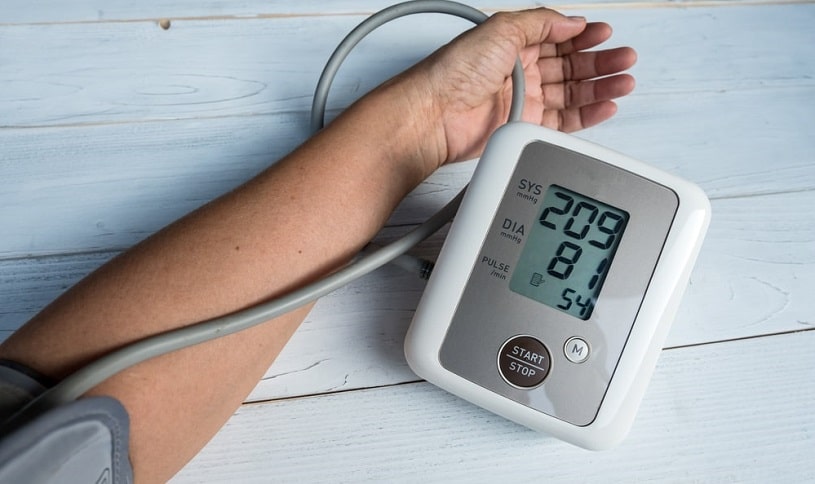Catapres is an effective medication with a wide array of uses. The Clonidine classification of drugs is known as centrally-acting alpha agonists. This is because they activate receptors in the brain known as alpha-adrenergic receptors. It is commonly sold under the brand name Catapres or Kapvay.
What is Clonidine used for? How does it help with anxiety or withdrawals? This article will provide answers.
Table Of Contents:
What Is Clonidine Used For?
Clonidine mechanism of action gives this drug many applications in the body. There are several health conditions that it can be used to treat depending on the dose used. Some of these are approved by the Food and Drug Administration, but others are off-label Clonidine uses.
So, what is Clonidine used for?
Based on Information From the United States Food and Drug Administration, the Following Are The FDA-Approved Uses:
- High blood pressure (Hypertension): The drug can be used on its own or in combination with other antihypertensive drugs. Using it alongside other antihypertensive drugs is beneficial when high blood pressure is difficult to control due to its mechanism of action.
- Attention-Deficit Hyperactivity Disorder (ADHD): The FDA also approves it for the treatment of ADHD. Doctors can combine it with the stimulant drugs used to treat the condition for more efficacy.
There are more off-label Clonidine uses for this medication than those that are FDA-approved. It demonstrates the versatility of this medication to an extent.
The Following Are the Off-Label Clonidine Uses:
- Tics: It has been found that it can improve tics seen in patients with Tourette’s syndrome. It works by acting on a different chemical system to dopamine by stimulating adrenaline receptors in the brain.
- Cancer-related pain: Its CNS action gives this medication analgesic effects that make it useful in the treatment of severe pain in cancer, though it should be added to other analgesics.
- Hot flashes: It is used to treat hot flashes associated with menopause when hormone replacement therapy is not desired. The medicine slows the reaction of the blood vessels to stimuli that cause them to narrow and widen.
- Symptoms of autism: Children with autism spectrum disorders are used to having sleep and behavioral problems. Catapres is an efficient drug to cope with impulsivity, inattention, and hyperactivity, in these children.
- Post-traumatic stress disorder (PTSD): This is a health condition that occurs after catastrophic stress. It can help lower anxiety and reduce aggression.
- Restless legs syndrome: It may be an effective treatment for patients who don’t have large numbers of sleep-disrupting periodic limb movements but have delayed sleep onset due to leg sensations and subsequent motor restlessness.
- Excessive sweating: Because emotional sweating is under sympathetic control, the drug could be helpful in it, especially when antidepressants cause the condition.
- Anxiety: Clonidine for anxiety works by reducing the activity of the sympathetic nervous system. It can be used on its own to treat this health condition.
Catapres For High Blood Pressure
The development of Catapres was centered around its effect in lowering blood pressure. It was approved for the treatment of high blood pressure in 1974. Catapres drug class belongs to centrally acting alpha-agonist hypotensive agents. Сlonidine HCl can reduce tone in the sympathetic section of the central nervous system. It leads to an effective decrease in pressure on the vascular walls, changing the total vascular resistance of the vessels. As a result, the number of heart muscle contractions and the volume of the output from the heart are effectively reduced.

Besides the heart, this medication can also influence the peripheral blood vessels. That is why when the patient starts to use this medicine, it can cause a rise in pressure for a short period of time. At the same time, Catapres helps to reduce intraocular pressure, performing sedative and analgesic effects.
Clonidine For ADHD
The FDA approves the use of this drug for the medical treatment of ADHD, and through information gained from studies, it has shown some improvement in symptoms.
Clonidine for ADHD in children helps reduce hyperactive symptoms and cope with accompanying sleep disturbances. According to the investigation made among children (4-12 y.o) and adolescents (13-17 y.o.), its use for more than one year has shown a positive response. The results were the same for those taking the drug exclusively at bedtime or during the day. Only 31% of patients had adverse effects during medical therapy.

It should be noted that the drug is approved for use specifically in those between the ages of 6 and 17. While not approved for adult treatment, information from a study shows that Clonidine for ADHD in adults does show improvement in hyperactivity and impulsivity symptoms. It is the only approved medication that can be added to the well-known stimulant therapy for treatment, though it can be used independently, too.
The benefit of its use for the medical treatment of ADHD is that it improves symptoms significantly whether used alone or as an adjunct. It does come with its side effects, including fatigue, drowsiness, throat pain, insomnia, and nightmares.
Clonidine For Anxiety
It is not one of the first-line drugs for the medical treatment of anxiety disorders, and neither is it approved by the Food and Drug Administration for that condition. However, Clonidine for anxiety has shown efficacy for treating the health condition, mainly with a decrease in the frequency of anxiety attacks. It does this by decreasing the fight-or-flight response by reducing sympathetic activity in the CNS. However, 17% of the patients examined in the study provided the information that their symptoms had worsened. It was based on the use of Clonidine for anxiety alone without any adjunct.
Clonidine For Sleep
The FDA does not approve the use of Clonidine for sleep disorders. However, one of Clonidine side effects is drowsiness. When it was noticed, the medication was applied to help in the management of insomnia. Information from studies shows that it has been proven to reduce the time it takes to fall asleep and reduce the frequency of nighttime awakenings.

One disadvantage is that Clonidine for sleep disorders causes a decrease in REM sleep when used at a medium dose. However, used at a low dose, it increases REM sleep.
Clonidine For Withdrawal
One of the most popular off-label Clonidine uses is Clonidine for withdrawal treatment. It can assist in the withdrawal from opioids, nicotine, alcohol, and benzodiazepines.
It does this by reducing the sympathetic nervous system activity, which reduces withdrawal symptoms such as high blood pressure, increased heart rate, restlessness, and fatigue. Its sedative effects, which are seen with Clonidine for sleep disorders, can also calm down patients dealing with withdrawal. It makes the withdrawal period easier for addicts to overcome.
The hydrochloride (HCl) version of this drug and naltrexone are used together to safely and extremely rapidly treat abrupt withdrawal from methadone. As for using Clonidine in withdrawal from alcohol, it could be prescribed to use Catapres in combination with benzodiazepine drugs such as Librium, Valium, or Xanax.
When To Take Catapres
Clonidine uses should be appointed only by a doctor. It is essential not to take any other drugs during Catapres treatment without approval from a doctor. Many interactions with other drugs like Catapres and Adderall can lead to adverse health effects and Clonidine toxicity. Also, when the medication is withdrawn suddenly, it can cause Catapres withdrawal symptoms. The dose for treating these different indications varies. Only a doctor should determine the dose.
Catapres side effects can appear like in case with any other medication. If any of them occur and worsen a patient’s health condition, the best way to prevent strong effects is to address complaints with a doctor as soon as possible. In cases of drug discontinuation, patients should consult with a doctor on how to safely stop taking it.
For those dealing with Catapres abuse, it’s better to get help before it gets worse. Such patients should seek help in drug rehabilitation facilities. These centers are designed to provide a full spectrum of the required addiction treatment.
Hope Without Commitment
Find the best treatment options. Call our free and confidential helpline
Most private insurances accepted
Page Sources
- Prince, J. B., Wilens, T. E., Biederman, J., Spencer, T. J., & Wozniak, J. R. (1996). Clonidine for sleep disturbances associated with attention-deficit hyperactivity disorder: a systematic chart review of 62 cases. Journal of the American Academy of Child and Adolescent Psychiatry, 35(5), 599–605. https://pubmed.ncbi.nlm.nih.gov/8935206/
- Eddy, C. M., Rickards, H. E., & Cavanna, A. E. (2011). Treatment strategies for tics in Tourette syndrome. Therapeutic advances in neurological disorders, 4(1), 25–45. https://www.ncbi.nlm.nih.gov/pmc/articles/PMC3036957/
- Neil M. J. (2011). Clonidine: clinical pharmacology and therapeutic use in pain management. Current clinical pharmacology, 6(4), 280–287. https://pubmed.ncbi.nlm.nih.gov/21827389/
- Charney, D. S., Riordan, C. E., Kleber, H. D., Murburg, M., Braverman, P., Sternberg, D. E., Heninger, G. R., & Redmond, D. E. (1982). Clonidine and naltrexone. A safe, effective, and rapid treatment of abrupt withdrawal from methadone therapy. Archives of general psychiatry, 39(11), 1327–1332. https://pubmed.ncbi.nlm.nih.gov/7138234/
- Cushman P., Jr (1987). Clonidine and alcohol withdrawal. Advances in alcohol & substance abuse, 7(1), 17–28. https://pubmed.ncbi.nlm.nih.gov/3327372/
- Ming, X., Gordon, E., Kang, N., & Wagner, G. C. (2008). Use of clonidine in children with autism spectrum disorders. Brain & development, 30(7), 454–460. https://pubmed.ncbi.nlm.nih.gov/18280681/
- Wagner, M. L., Walters, A. S., Coleman, R. G., Hening, W. A., Grasing, K., & Chokroverty, S. (1996). Randomized, double-blind, placebo-controlled study of clonidine in restless legs syndrome. Sleep, 19(1), 52–58. https://pubmed.ncbi.nlm.nih.gov/8650464/
- Lange, J. T., Lange, C. L., & Cabaltica, R. B. (2000). Primary care treatment of post-traumatic stress disorder. American family physician, 62(5), 1035–1046. https://pubmed.ncbi.nlm.nih.gov/10997529/
- Hoehn-Saric, R., Merchant, A. F., Keyser, M. L., & Smith, V. K. (1981). Effects of clonidine on anxiety disorders. Archives of general psychiatry, 38(11), 1278–1282. https://pubmed.ncbi.nlm.nih.gov/7305609/
- Naguy A. (2016). Clonidine Use in Psychiatry: Panacea or Panache. Pharmacology, 98(1-2), 87–92. https://pubmed.ncbi.nlm.nih.gov/27161101/
- Yasaei R, Saadabadi A. (2021). Clonidine. Treasure Island (FL): StatPearls Publishing; https://www.ncbhypertensioni.nlm.nih.gov/books/NBK459124/
- Ming, X., Mulvey, M., Mohanty, S., & Patel, V. (2011). Safety and efficacy of clonidine and clonidine extended-release in the treatment of children and adolescents with attention deficit and hyperactivity disorders. Adolescent health, medicine and therapeutics, 2, 105–112. https://www.ncbi.nlm.nih.gov/pmc/articles/PMC3926778/
- Miyazaki, S., Uchida, S., Mukai, J., & Nishihara, K. (2004). Clonidine effects on all-night human sleep: opposite action of low- and medium-dose clonidine on human NREM-REM sleep proportion. Psychiatry and clinical neurosciences, 58(2), 138–144. https://pubmed.ncbi.nlm.nih.gov/15009817/
- Philipp, M., Brede, M., & Hein, L. (2002). Physiological significance of alpha(2)-adrenergic receptor subtype diversity: one receptor is not enough. American journal of physiology. Regulatory, integrative and comparative physiology, 283(2), R287–R295. https://pubmed.ncbi.nlm.nih.gov/12121839/
- Kolar, D., Keller, A., Golfinopoulos, M., Cumyn, L., Syer, C., & Hechtman, L. (2008). Treatment of adults with attention-deficit/hyperactivity disorder. Neuropsychiatric disease and treatment, 4(2), 389–403. https://www.ncbi.nlm.nih.gov/pmc/articles/PMC2518387/
- United States Food & Drug Administration, Drugs@FDA: FDA-Approved Drugs: Clonidine, https://www.accessdata.fda.gov/scripts/cder/daf/index.cfm?event=overview.process&ApplNo=017407

 Authored by
Authored by  Reviewed by
Reviewed by 